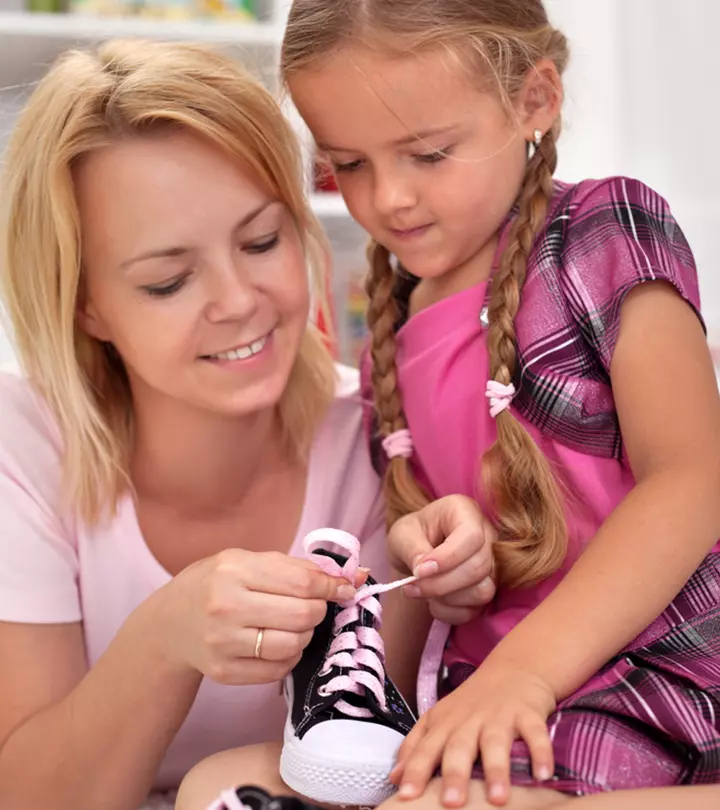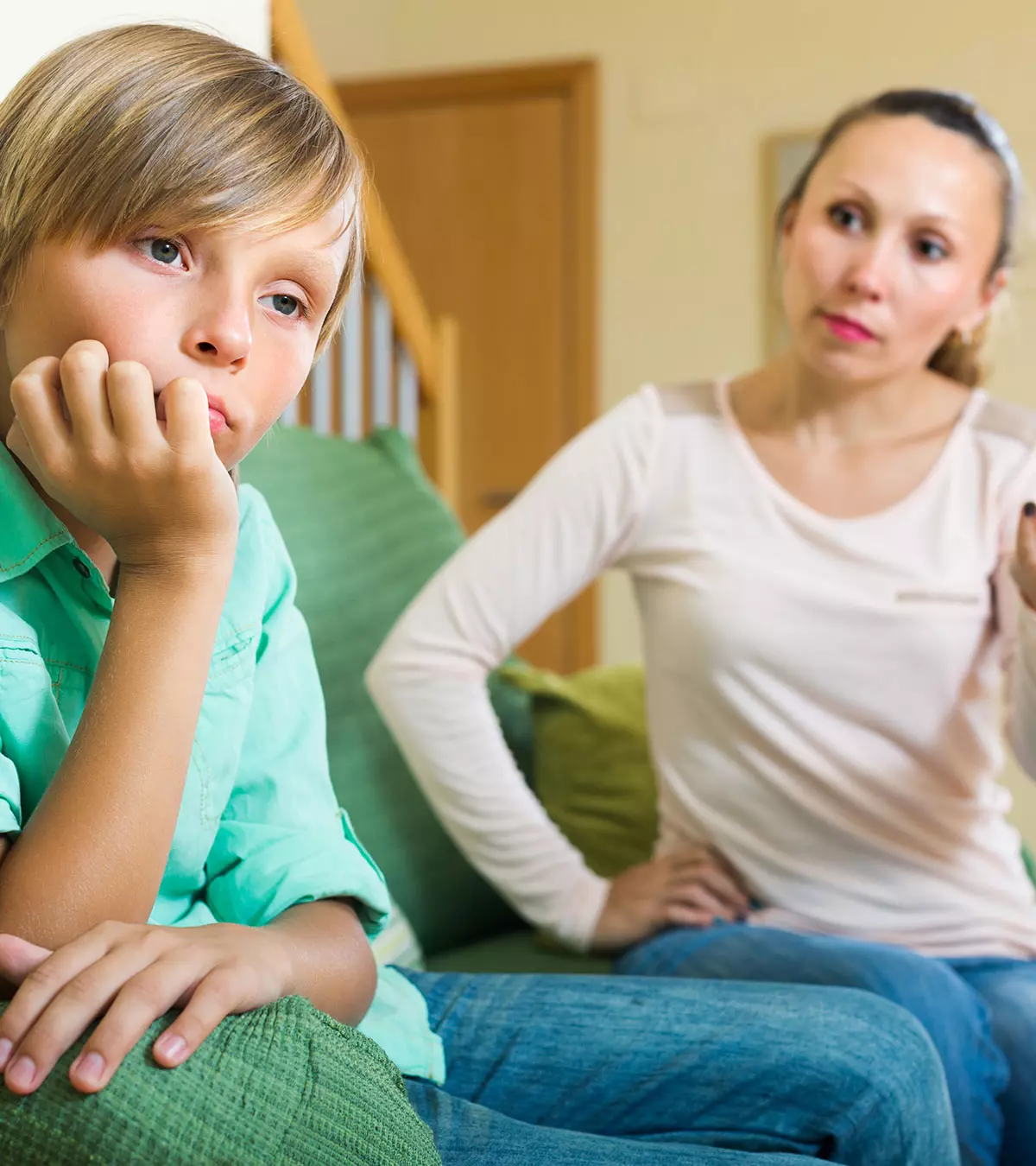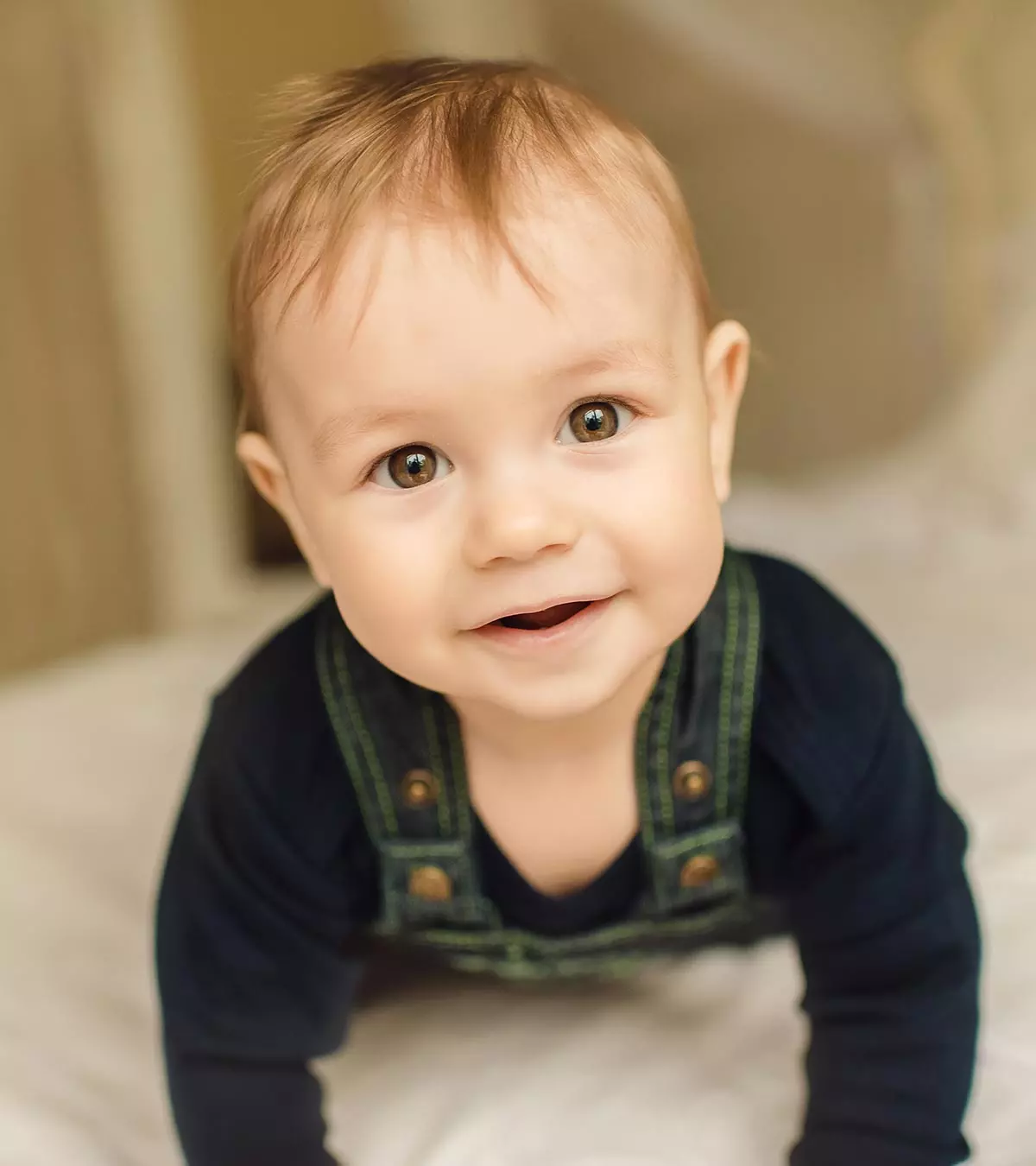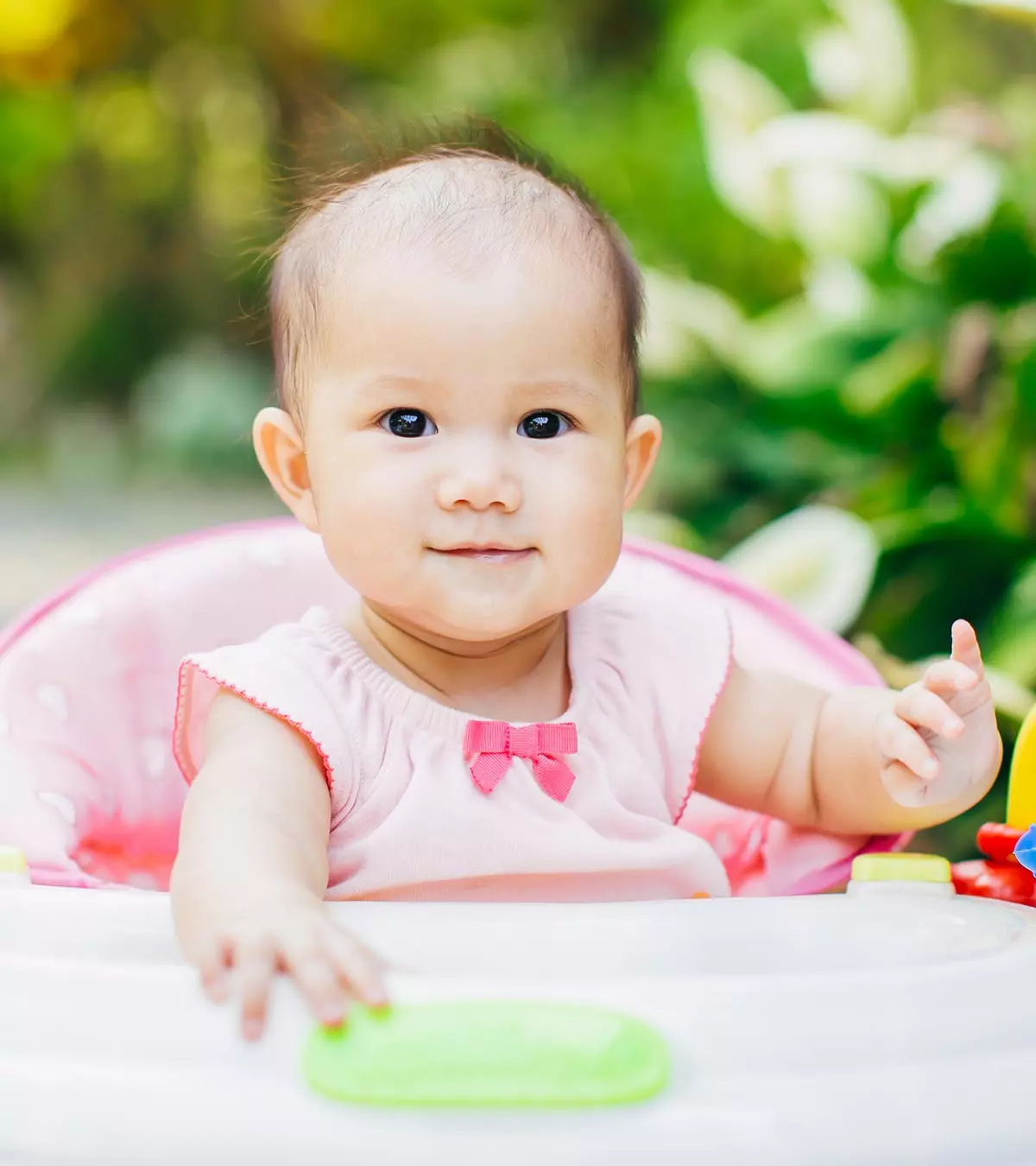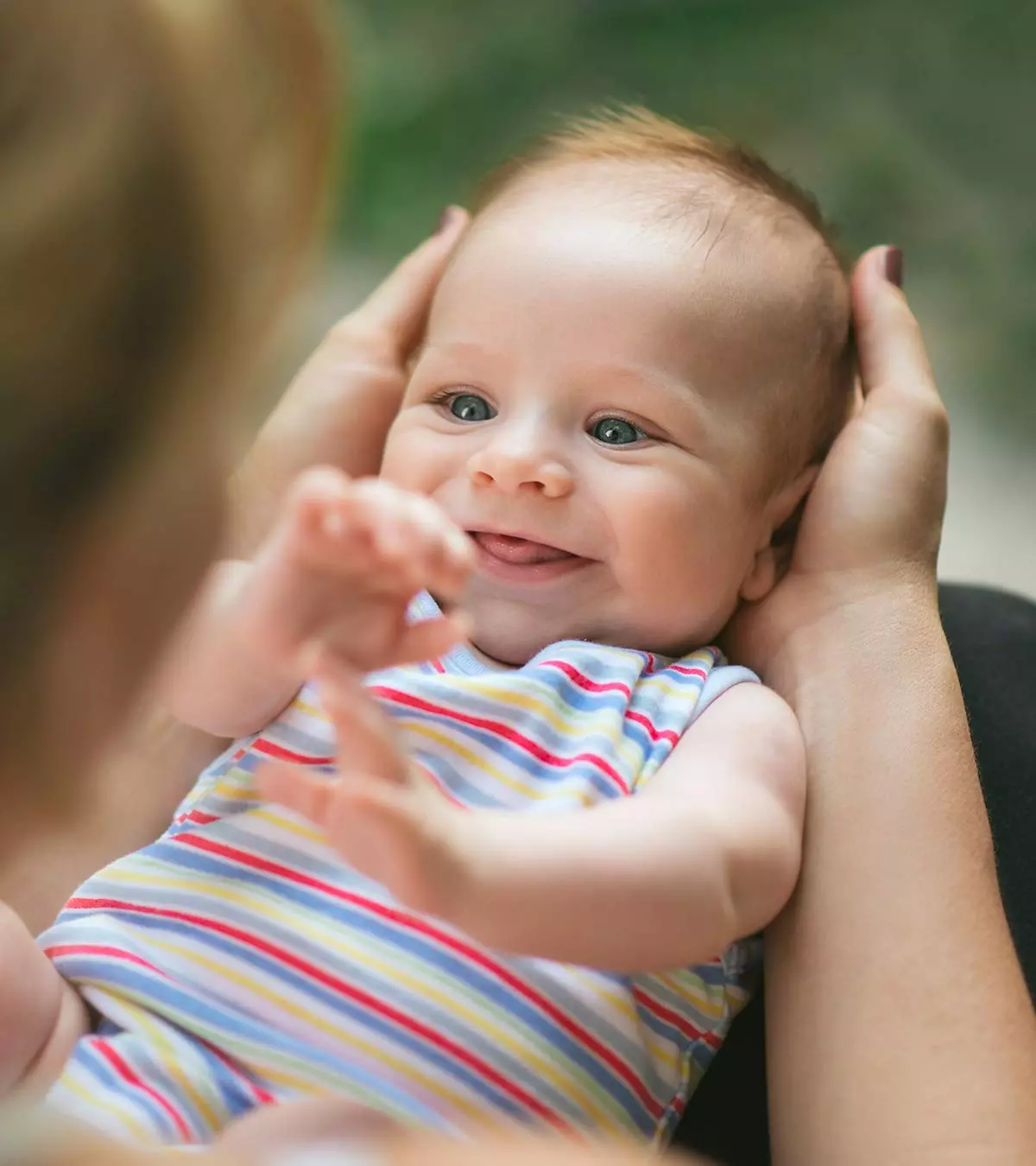
Image: ShutterStock
Since their first cry, your baby has come a long way. If you observe your 2-month-old’s milestones, you’ll notice that your baby now pays attention to faces, turns their head toward sounds, and smiles at familiar faces. There is also a significant increase in physical growth. However, that’s not all – two-month-old babies are capable of so much more.
This post discusses the developmental milestones most babies achieve by two months, how to recognize the warning signs of developmental delays, and some tips to help parents aid the development of their two-month-old.
Key Pointers
- At two months old, a baby may recognize faces, locate the source of sounds, and have different crying tones.
- The baby’s neck muscles become stronger, their vision and muscle control improve, and their newborn reflexes start disappearing.
- The baby can now respond with coos and gurgles, smile at people, and become fussy when bored.
- It’s important to engage the baby in games that stimulate different senses, have adequate social interaction, and have regular tummy time.
- If a two-month-old baby cannot hold their head up, make any cooing sounds, or bring their hands to their mouth, it’s recommended to consult a pediatrician.
2-Month-Old’s Milestones Chart
| Achieved developmental milestones | Emerging developmental milestones |
|---|---|
| Raises head 45 degrees when on tummy | Can raise head by 90 degrees when on tummy |
| Holds head straight during supported sitting | Can raise head and look up during supported sitting |
| Supports partial weight on elbows | Can bear complete weight on elbows and forearms |
| Visually follows objects moving in short arc | Will follow objects within 180 degrees of line of sight |
| Searches for sound source by turning head | Can turn straight to the source of the sound |
| Recognizes faces | Can recognize faces, objects, and voices |
| Coos and gurgles | Will make more sounds such as squealing and babbling |
| Smiles at familiar faces | Can smile spontaneously at people |
| Gets fussy when bored | Will display fussiness in more specific situations |
| Responds to voices with coos | Will try imitating voices and tone |
2-Month-Old Baby’s Developmental Milestones
A baby displays progress in three areas of development namely cognitive, physical, and social and emotional. Each category presents its unique set of skill achievement.
Cognitive developmental milestones
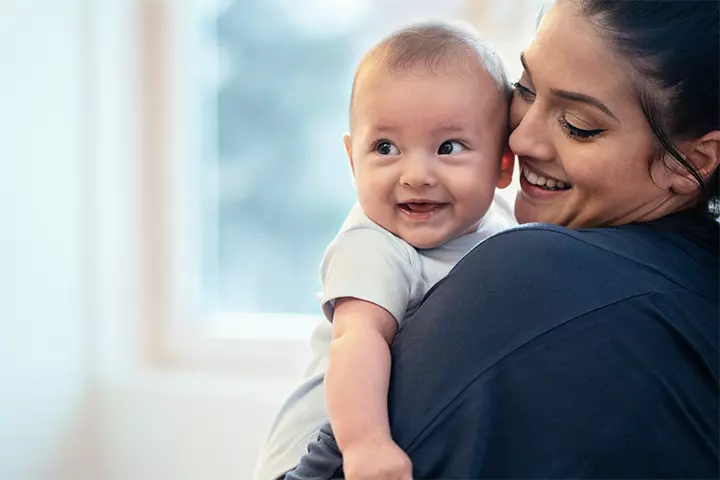
These milestones are about a two-month-old’s brain development, cognitive functions, and cognitive prowess.
- Pays attention to faces: Gone are the days when the baby would look at faces as if seeing through a haze. A two-month-old intently looks at someone’s face, focuses on the face, and maintains steady eye contact, especially with primary caretakers such as parents. Recognition comes. This is one of the important signs of cognitive development.
- Can locate sound source: A better coordination of hearing and brain functions brings the ability to locate the source of the sound. The two-month-old turns his head around, searching for the sound source, for instance, the location of a moving rattle, a talking person. This can be tested by clapping on either side of the baby and seeing if the baby turns the head (1).
- Has different crying tones: The baby cries when hungry differ from those when he just soiled. The baby’s mind is capable of prompting different vocalizations to convey distinct feelings (2).
- Recognizes people at a distance: Memory and recall grow in leaps and the baby is quite capable of recognizing faces even at a distance.
 Did you know?
Did you know?Physical development milestones

These landmarks indicate a baby’s physical development, including their growth and muscular abilities.
- Head stays straight when held in sitting position: The head no longer falls backward when the infant is held in sitting position. Neck holding starts and this is an important milestone. Neck muscles in a two-month-old baby are stronger, which means he keeps his head straight while sitting up with support.
- Lifts head nearly 45 degrees when on tummy: Stronger neck muscles help the baby raise his head against gravity when he is placed on the stomach. At the age of two months, a baby can raise the head up by 45 degrees during tummy time.
Lindsey Brooke, a mother of two from Nashville, followed a daily routine of giving tummy time to her baby. In her YouTube video, she says, “We always practice rolling over. I kind of help her, just so she is getting used to that motion. She does some tummy time, she is lifting her head, and it is getting so strong (i).”
- Partially pushes up when on tummy: The infant presses on the elbows and tries pushing up the body upwards from the tummy. Stronger shoulder muscles and joints help achieve this ability.
- Follows moving objects with eyes: Swing around an object in front of the baby from side to side, and the little one will have his eyes fixed on it, visually tracking its movement. A two-month-old baby can track objects moving in an arc with a coordinated movement of the eyes and neck. Keep the head steady and movement of the eyes takes place.
- Better control on limb muscles: The baby now makes less jerky and smoother movements with limbs. It is due to a substantial improvement in the motor skills that helps in better voluntary muscle control.
- Some newborn reflexes disappear: The development of more rhythmic muscle control diminishes innate neonatal reflexes. For instance, the palmar grasping reflex fades at the age of two months as the infant learns to spend time with an unclenched fist (3).
- Improved vision and eye coordination: The baby pays attention to face details and discerns color better. The coordination between the muscles of both eyes improves, and the baby soon tracks slow-moving objects in close range.
- Listens to voices and high-pitched sounds: Babies at two months love hearing the voices of parents and respond by looking in the direction of the sound’s source. They may try recognizing familiar voices and sounds. The baby will also react to high-pitch sounds such as singing and music, indicating a significant improvement in hearing skills since birth (4).
 Do remember
Do rememberSocial and emotional developmental milestones

This category presents milestones that define social skills and progress in emotional temperament.
- Smiles at people: Smiling and laughing softly is the most significant milestone of social development in infancy, and you see it first at the age of two months. The baby responds to a smile with a smile, cooing, babbling, and loving sounds, especially to that of the parents.
Seeing your baby smile for the first time can be a wonderful experience. As Catherine Thompson, mother of two and sleep consultant succinctly puts in her 6th week entry about her baby daughter, “We had her first smiles this week, a magical moment which brought a tear to my eye (ii).”
- Responds to questions with coos and gurgles: When you speak to the baby, he will respond with coos and gurgles, as if trying to talk back. These sounds are incoherent and meaningless but are the foundation for building their communication skills and having meaningful conversations later in life.
- Can calm oneself briefly: The baby will try to self-soothe during crying bouts by bringing his hands to the mouth and sucking his thumb. It is an ingrained soothing method.
- Grumbles and acts fussy when bored: For the first time, the baby begins to display boredom and will cry fussily while growing disinterested in an activity or toy at hand. Fussiness is a significant hallmark of the baby’s behavior at the age of two months.
 Quick tip
Quick tipEach baby is different and could take more time than other babies his age to attain sensory or emotional development and achieve a milestone. Parents tend to compare their babies to other babies. To an extent this is fine but each baby follows its own developmental time line and the time line can vary. The concern should take place when the delay is more than a few months. While a bit of delay is normal, you must take the baby to a doctor if the development is way too delayed.
When To Be Concerned?

The US Centers for Disease Control and Prevention (CDC) recommends parents to be alert about these delays in a two-month-old’s growth.
- Does not hold head up when pushing up from tummy.
- Unable to support the head when sitting with support.
- Does not bring hands to the mouth.
- Does not follow objects as they move.
- Never smiles and does not make cooing sounds.
- Does not turn head towards sounds around or is incapable of responding to sounds.
Take the baby to a doctor for a checkup when you notice something amiss. The American Academy of Pediatrics (AAP) recommends screening infants at regular intervals to detect developmental delay and mitigate their effects (5). And, as parents, you can always work on helping your little one grow the healthy way.
How Can Parents Help In The Development Of A 2-Month-Old?
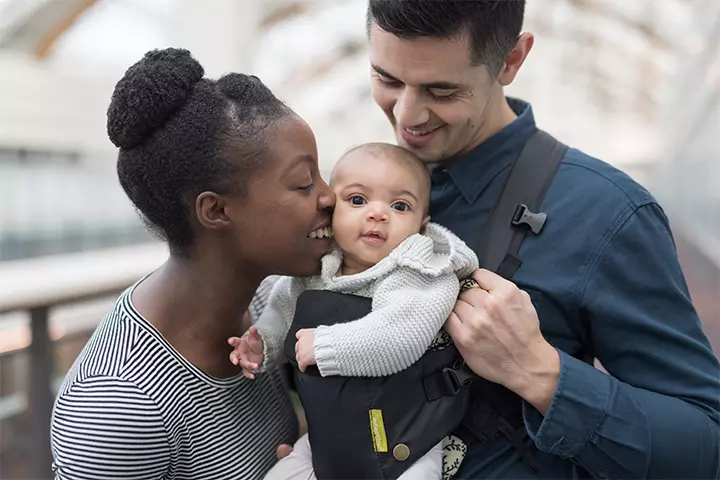
Here are some tips to ensure a healthy growth of your two-month-old:
- Have regular tummy time: Tummy time activity strengthens the core muscles while benefiting the infant’s neck and arm muscles. Pediatric experts recommend tummy time as an ideal way of stimulating a baby’s physical growth (6). Have at least three sessions of tummy time in a day with each session lasting five minutes.
- Play games that stimulate the senses: Encourage a baby to find a source of a sound or spot his parents from a distance. Such games involve the active use of senses thus aiding their sensory development. You can also introduce 2-month-old baby activities to enhance their skills.
- Have adequate social interaction: The baby’s first social skills take shape now. Spend time in social play such as family interactions, which help the baby remember and recall faces.
- Read to them: While infants may not recognize words and pictures, they are drawn to bright colors and find being read to soothing. Reading to your baby also promotes language development and familiarizes them with sounds and rhythms of speech.
 Point to consider
Point to considerFrequently Asked Questions
1. How often should a two-month-old preemie eat?
Premature babies may need to be fed 8-10 times a day (8).
2. Is it okay to make a two-month-old sit?
You can try to support your baby to sit up for short durations if you notice them using their neck and shoulder muscles often (9).
3. Can a two-month-old recognize mom?
Yes, babies usually start recognizing their mother’s face and voice from two to three months of age (10).
4. How much should a 2-month-old baby weigh?
According to the WHO weight for age chart, on average, a two-month-old baby girl should weigh around 5.2kgs while a baby boy should weigh around 5.6kgs (10). However, the appropriate weight of the baby may vary on several factors, including if they were preemie or have congenital conditions. Consult a pediatrician to determine the right weight for your two-month-old.
5. Why are health check-ups important for a two-month-old?
Regular health check-ups with an expert help monitor your baby’s growth and ensure they receive necessary vaccinations such as DTaP, Hib, and polio, which protect against serious diseases.
6. Which vaccines should a 2-month-old baby receive?
According to the CDC, a 2-month-old child should get vaccinations that protect them from diseases such as diphtheria, tetanus, whooping cough, hepatitis B, haemophilus influenza type b, polio, rotavirus, and pneumococcal disease (11).
7. Is giving my 2-month-old infant formula okay, or should I feed them only breastmilk?
An infant can be given infant formula that offers the necessary nutrients required for the growth and development of a baby. However, as per research, a woman’s breast milk is the best source of nutrition for an infant. It contains rich antibodies that help the child develop immunity and boost their growth (12).
A two-month-old baby might take you by surprise by the number of things they have learned already. You will find them having enhanced head control, supporting weight on elbows, moving their neck to the direction of the sound, and doing many more cute things. Your little one may also begin to observe people and identify them with those curious little eyes. However, every child is unique and may reach a milestone at their own pace. But if you feel they are lagging or showing delays in reaching milestones, contact your pediatrician to get some clarity.
Infographic: Feeding Milestones For A 2-Month-Old
Your baby should have achieved significant feeding milestones at the age of two months. This infographic gives insights on what stage of feeding your 2-month-old should have reached. It also presents some feeding tips for parents to follow. Save and share it with your mom-friends. Illustration: Momjunction Design Team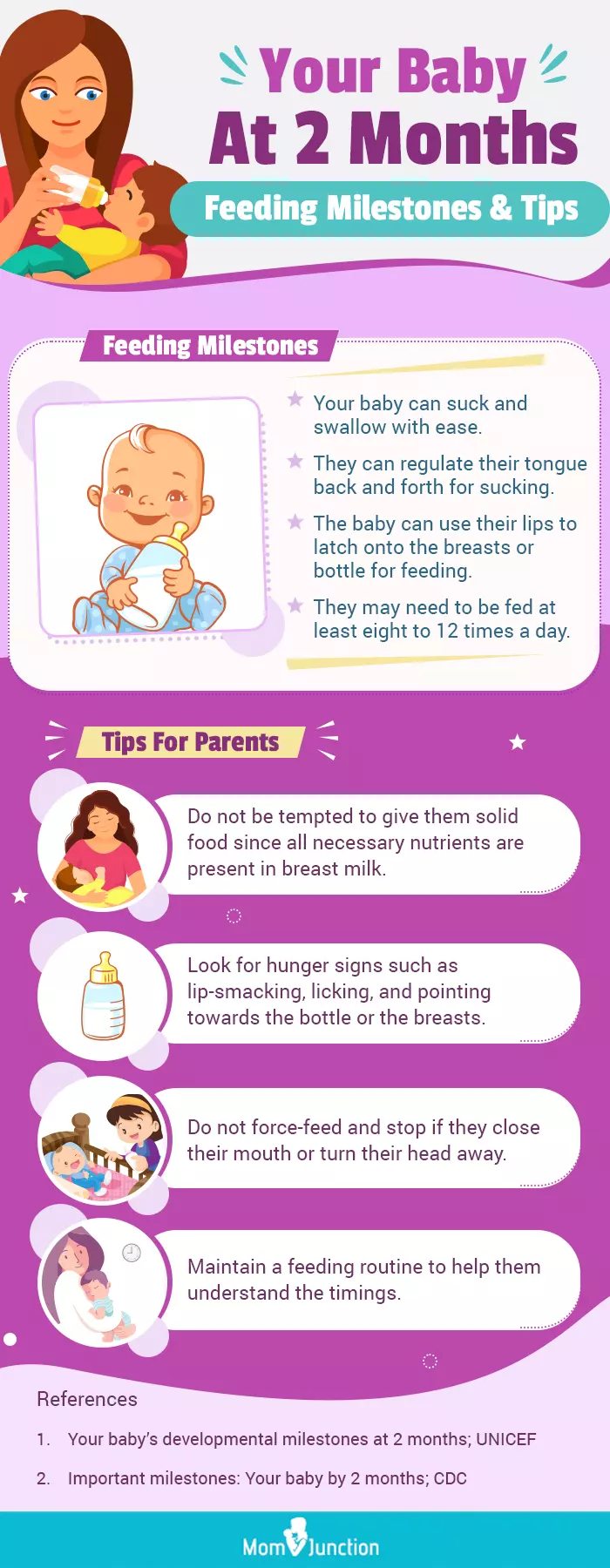
Illustration: 2-Month-Old’s Milestones Charts And Development Tips
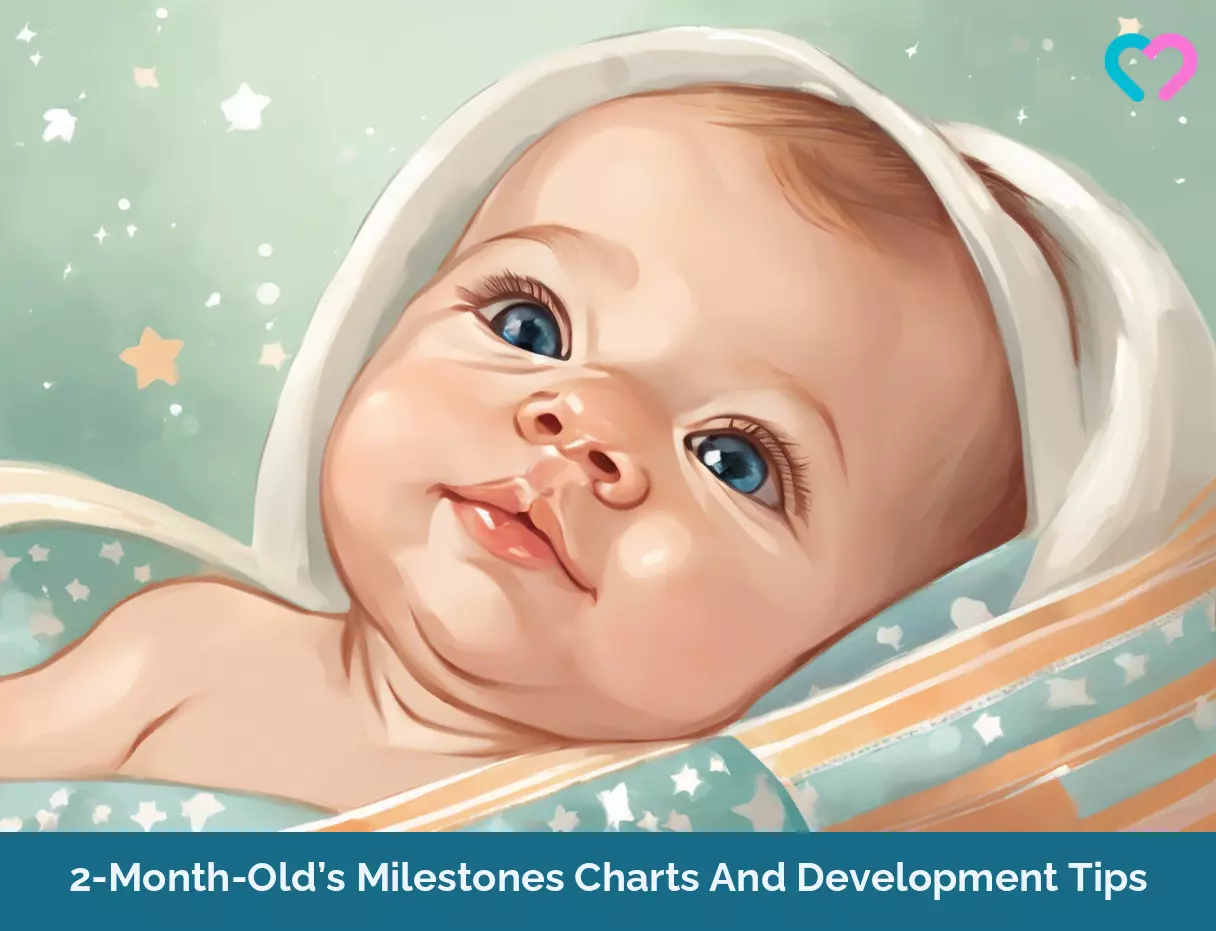
Image: Stable Diffusion/MomJunction Design Team
Personal Experience: Source
MomJunction articles include first-hand experiences to provide you with better insights through real-life narratives. Here are the sources of personal accounts referenced in this article.
i. 24 Hours With A 2 Month Old.https://www.youtube.com/watch?v=2bnEqiWiBhA
ii. My 2 Month Old Baby Blog Story.
https://completelybaby.com/blog/2-month-old-baby-blog-story/
References
- Important Milestones: Your Baby By Two Months.
https://www.cdc.gov/ncbddd/actearly/milestones/milestones-2mo.html - First Year Infant Development.
https://americanpregnancy.org/healthy-pregnancy/first-year-of-life/first-year-infant-development/ - Newborn reflexes.
https://www.healthychildren.org/English/ages-stages/baby/Pages/Newborn-Reflexes.aspx - Your Baby’s Hearing, Vision, and Other Senses: 2 Months.
https://kidshealth.org/en/parents/senses-2mos.html - Developmental Monitoring and Screening.
https://www.cdc.gov/ncbddd/actearly/screening.html - Back to Sleep Tummy to Play.
https://www.healthychildren.org/English/ages-stages/baby/sleep/Pages/Back-to-Sleep-Tummy-to-Play.aspx - Caring for your premature baby.
https://familydoctor.org/caring-for-your-premature-baby/ - Your baby at 2 months.
https://www.ucsfbenioffchildrens.org/education/your-baby-at-2-months - Newborn development at 2-3 months.
https://raisingchildren.net.au/newborns/development/development-tracker/2-3-months - Weight-for-age.
https://www.who.int/tools/child-growth-standards/standards/weight-for-age - Vaccines by Age.
https://www.cdc.gov/vaccines/by-age/?CDC_AAref_Val=https://www.cdc.gov/vaccines/parents/by-age/months-1-2.html - Camilia R. Martin et al.; (2016) Review of Infant Feeding: Key Features of Breast Milk and Infant Formula.
https://www.ncbi.nlm.nih.gov/pmc/articles/PMC4882692/
A 2-month-old baby is growing and developing quickly! Learn about the most important milestones to look out for in this video.
Community Experiences
Join the conversation and become a part of our nurturing community! Share your stories, experiences, and insights to connect with fellow parents.
Read full bio of Dr. Mubina Agboatwalla
Read full bio of Rohit Garoo
Read full bio of Dr. Ritika Shah
Read full bio of Vibha Navarathna








